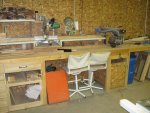Cynthia White
Member
- Messages
- 3,220
Hi David, Welcome. Greetings from the Pacific Northwest. 




Your plan looks very workable but, what is that large rectangular tool in the middle of the floor labeled "truck". . .
Amen! Even when my shop was our two-car garage down in Florida and I worked with the large door open most of the year, I added a 1.5hp DC to help control dust. After our move to Georgia, I built an addition to an existing shop building. Prior to having it dried in and secured, I was already working with Oneida on a layout for a 3hp DC and ducting. As soon as I could lock up the place, I ordered the DC and the first few pieces of duct. I didn't want to rush into running a bunch of duct only to decide on a different tool arrangement, so my initial use of the new DC was via two 4" flex hoses. As I solidified my tool layout, I added main duct and drops.OK, no one has said it yet so I will toss it out there; your drawing doesn't show the primary tool every shop should have . . . a dust collector. Address this critical need sooner rather than later. I chose later and now have a sensitivity which I will carry for the rest of my life.

Oops, mislabled, shoulda been "lumbercart"
 Oh yeah. David's gonna fit right in.
Oh yeah. David's gonna fit right in. 
